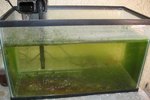
Replacing substrate in a saltwater tank is not recommended if the existing substrate isn’t causing a threat to aquatic life. It's discouraged because disrupting the substrate can stir bacteria, ammonia and waterborne compounds that are trapped in the substrate, disrupting the delicate balance of the tank. When substrate is no longer fit for a fish tank, though, it's time to swap it for new.
Select a New Substrate
Sand substrate is known to cause nutrient levels to rise over time, making it necessary to replace sand every two to five years. Sand substrates collect detritus -- which is why most saltwater tank enthusiasts regularly vacuum their sand beds. If you don’t have a vacuum, you may be interested in one of the other saltwater tank substrates available. They include aragonite, crushed coral, coral sand and crushed seashells. Aragonite is an especially good substrate option because it helps to regulate pH balances.
Clean the New Substrate
If your saltwater aquarium has a sand substrate, you may not want to clean it, as cleaning sand substrate can reduce the particle size in the sand bed. For all other substrates, fill a bucket no more than half full with the substrate. Then, fill the bucket with an equal amount of water. Mix the substrate into the water with your hands, allowing the water to become cloudy with any dust or dirt that may be on the substrate. Continue to fill the bucket with water, allowing the cloudy water to spill over the sides. When the water running over the sides is clear, the substrate is clean.
Changing the Substrate
Because a saltwater tank’s substrate contains a lot of nitrite and ammonia, it’s not recommended to completely remove all of the existing substrate in a single day. Instead, remove half the substrate one day and the other half in two weeks. An additional benefit is that you'll add new substrate to half the tank, reducing the amount of time the new substrate will need to settle. Begin by removing your fish. You can place them in a bowl or a bucket. Then, turn off your pumps. You can use your hands or a scoop to pull out the old substrate. Alternatively, if you want to ensure the tank stays clean during the process, you can use a hose to siphon out the old substrate. Place the old substrate in a bucket if you plan to keep it. Otherwise, throw it out.
Adding the New Substrate
You can lower gravel substrate into the tank using your hands or using the same scoop you used to remove the old substrate. Spread the gravel out once it's on the bottom. You can't lower sand substrate and other lightweight substrates to the bottom this way. Seal them in a freezer bag, and lower the sealed bag to the bottom of your tank. Then gently open it and pour the lightweight substrate along the bottom. Some particles will suspend in the water, but the method keeps things relatively settled.
Allow Everything to Settle
After you’ve added new substrate, the tank is likely going to be rather cloudy. Before reintroducing fish, allow all the substrate to settle and the water to clear. This can take as little as two hours or up to a full day. Speed the process by replacing 20 percent of the water. Even if you've replaced only half the tank's substrate, you can reintroduce your fish once the substrate has settled. Finally, turn on your pumps and add decor. Remember to remove the fish and accessories again in two weeks when replace the remaining substrate.
References
Resources
Photo Credits
-
John Foxx/Stockbyte/Getty Images
Writer Bio
Caryn Anderson combines extensive behind-the-scenes writing experience with her passion for all things food, fashion, garden and travel. Bitten by the travel bug at the age of 15 after a trip to Europe, Anderson fostered her love of style and fashion while living in New York City and earning her degree at New York University.




